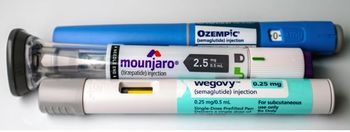
Kids Fed Snacks in Small Groups Eat More Moderately
ANN ARBOR, Mich. -- When preschoolers dive into snacks in large groups, they may eat more than when the snacks are offered to smaller groups, researchers here found.
ANN ARBOR, Mich., Feb. 15 -- When preschoolers dive into snacks in large groups, they may eat more than when the snacks are offered to smaller groups, researchers here found.
Children ate 30% more when snacking in a group of nine than in a group of three, reported Julie C Lumeng, M.D., and Katherine H Hillman, M.P.H., both of the University of Michigan, in a study published online in the Archives of Disease in Childhood.
The findings may have implications for both formation of lifelong eating habits as well as childhood obesity, Drs. Lumeng and Hillman said.
Merely the sight or sound of others engaged in the same behavior -- termed social facilitation -- has been shown to increase food consumption in adults by 30% to 50%, they said, although the effect has never been verified in children.
In the study of 54 children ages 2.5 to 6.5 years, the effect of group size on snacking was partially explained by an earlier start to eating, faster eating, and less social interaction when in larger groups, they said.
The study could not definitively say whether children overate in large groups or ate less than normal in small groups, they cautioned. "However, given that the social facilitation effect can overwhelm satiety mechanisms, its potential role in contributing to overconsumption, and thereby increasing overweight risk in children, deserves consideration in future research."
In the study, children at a university-based preschool were organized into groups of three that were then combined into larger groups of nine with randomized order of participation. For both, they were given their standard snack of graham crackers broken in half at the regular snack time, in a familiar quiet room, and supervised by their regular teachers and a familiar research assistant.
As they were accustomed to doing, the children (68% boys, 74% white) served themselves extra crackers from a communal plate and left the table when finished. There was no time or portion limit.
When videotapes were reviewed, the researchers found that children tended to eat more, faster overall, and with less socialization. For large versus small groups, the unadjusted findings were:
- Similar snack duration (12.4 versus 13.0 minutes, P=0.69),
- Similar amount eaten (24.8 g versus 21.2 g, P=0.21),
- Similar eating rate (2.9 versus 2.4 g/min, P=0.34),
- Significantly shorter latency period before starting to eat (1.9 versus 3.0 minutes, P=0.03),
- More adult prompts to eat (0.90 versus 0.35, P=0.0002), and
- Less social interaction (2.0 versus 3.1 rating, P<0.001).
When controlling for snack duration, the difference in consumption became significant between groups (P=0.03).
The researchers therefore looked at snacks by duration. They found:
- A nonsignficant effect during snacks that were shorter than the median 11.4 minutes (15.1 g large group versus 16.7 small group, P=0.42), and
- A significant 30% increase in consumption during longer snacks for the larger groups (34.5 g versus 26.5 g, P=0.02).
They also found a significant interaction between amount eaten and latency to eating initiation (P=0.04) as well as between consumption and eating rate (P=0.17 for first versus second quartile, P<0.001 for first versus third quartile, and P=0.01 for first versus fourth quartiles).
The findings support recommendations that families eat meals together at home, the investigators added.
"The child who eats inadequate quantities may consume more when eating in a group (e.g., with the family at the table for a planned mealtime) than when eating alone, as often occurs when children graze over the course of the day," they said.
"For the child who overeats, overconsumption may be driven by having meals in overstimulating busy or chaotic environments, as is often the case when eating out, particularly at fast food restaurants," they added.
The researchers cautioned that their small sample size may have limited the power of the study to detect more subtle effects. Also, the researchers did not collect information on the volume the children drank during the snacktime sessions, though beverage type was held constant for each child regardless of group size and would not expected to confound group size effects.
Newsletter
Enhance your clinical practice with the Patient Care newsletter, offering the latest evidence-based guidelines, diagnostic insights, and treatment strategies for primary care physicians.
































































































































































































































































































